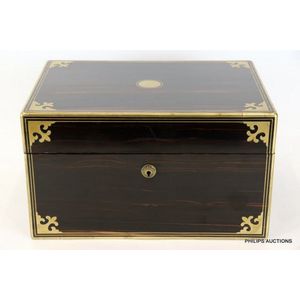Victorian Coromandel Vanity and Jewellery Box
A fine Victorian coromandel vanity, jewellery and stationery box, circa 1870s, a brass strapped box with striped veneers, having gothic spandrels, a concealed stationery compartment to the lid, compartments for assorted bottles (mixed and incomplete), removable tray and secret jewellery drawer to the short end, finely crafted throughout with Bramah lock and arched brass quadrant stays, with key (concealed mirror A/F), height: 18 cm, length 31 cm, width 22 cm
You must be a subscriber, and be logged in to view price and dealer details.
Subscribe Now to view actual auction price for this item
When you subscribe, you have the option of setting the currency in which to display prices to $Au, $US, $NZ or Stg.
This item has been sold, and the description, image and price are for reference purposes only.
- Circa - A Latin term meaning 'about', often used in the antique trade to give an approximate date for the piece, usually considered to be five years on either side of the circa year. Thus, circa 1900 means the piece was made about 1900, probably between 1895 and 1905. The expression is sometimes abbreviated to c.1900.
- Calamander / Coromandel - Calamander wood, also known as coromandel wood or coromandel ebony, is a type of hardwood that comes from the Calamander tree (Diospyros quaesita), which is native to Sri Lanka, India, and Southeast Asia. The wood is known for its dark brown or black colour and its distinctive figuring, which can resemble a snakeskin pattern.
The wood is highly prized for its beauty and durability. It is often used in fine furniture making, particularly in the production of inlaid and marquetry work, as well as in the making of boxes, cabinets, and other decorative items. It is also used in the manufacture of flooring, paneling and other architectural applications.
Calamander wood is a very hard and heavy wood, it has a density of around 1.04 g/cm3. Its density and high natural oil content make it resistant to decay and insects, which is why it is a popular choice for outdoor furniture, flooring and other decorative items.
The wood is also used for turning and carving, but is difficult to work due to its high density and interlocking grain. However, it takes a high natural polish and has a beautiful lustre, which is why it is so sought after.
Due to the high demand and over-exploitation of the natural resources, the calamander tree is now a protected species, and the harvesting and export of the wood is heavily regulated. - Victorian Period - The Victorian period of furniture and decorative arts design covers the reign of Queen Victoria from 1837 to 1901. There was not one dominant style of furniture in the Victorian period. Designers used and modified many historical styles such as Gothic, Tudor, Elizabethan, English Rococo, Neoclassical and others, although use of some styles, such as English Rococo and Gothic tended to dominate the furniture manufacture of the period.
The Victorian period was preceded by the Regency and William IV periods, and followed by the Edwardian period, named for Edward VII (1841 ? 1910) who was King of the United Kingdom and the British Dominions and Emperor of India for the brief period from 1901 until his death in 1910. - A/f, as Inspected - The letters "A/F" or "as inspected" as part of a description is the cataloguer's shorthand for "all faults" or "as found", meaning the item has some type of damage or deficiency, it is of uncertain date or provenance, and/or that the seller takes no responsibility for the completeness of the item or the accuracy of the description.
This item has been included into following indexes:
- boxes, function
- boxes, material or decoration - coromandel boxes 45
